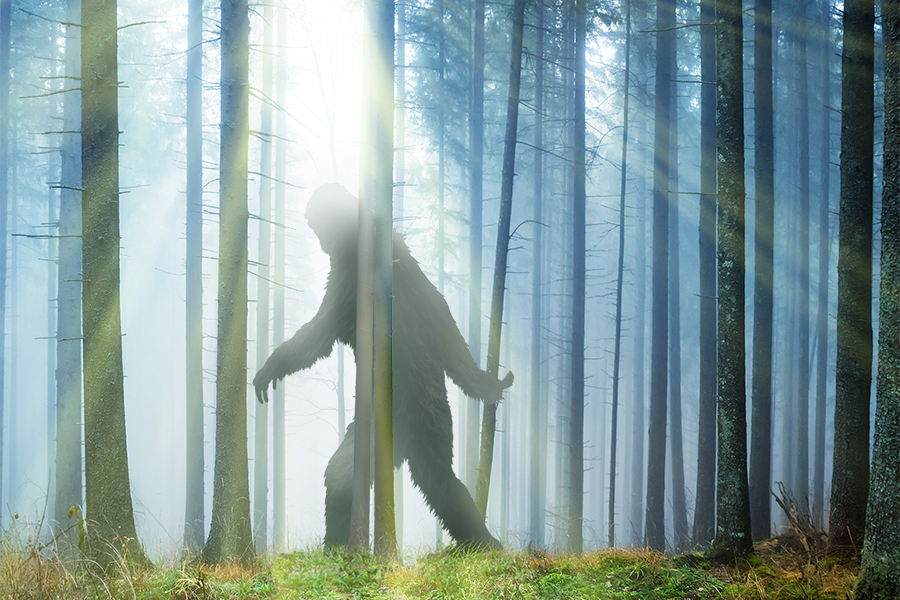HOT SPRINGS – The morning of Oct. 24 was one of chill and fog, with gray, opaque clouds hanging low over Flathead Lake and the pavement on U.S. Highway 93 punctuated with fresh, dark blood.
Sure, the gore was just a sign that the local deer have begun the annual process of losing their minds during mating season and are running into the road, but since I was on my way to a conference about monsters, it was easy to let the mind wander to spookier and more sinister explanations.
Beacon photographer Greg Lindstrom and I headed out early that Saturday morning, driving the windy road to Hot Springs, where the inaugural Big Sky Bigfoot Conference was scheduled to take place at the historic Symes Hot Springs Hotel.
As we turned off Highway 28 and onto Highway 77 taking us into the town, our spotty cell reception dropped off completely. What might have been an annoyance any other time became just another way to set the scene: we were leaving our worldviews on Highway 28 and entering a new realm, where mythology and reality are braided together, making it tough to distinguish one from the other.
Symes was bustling already despite the relatively early hour, with guests basking in the warm, mineral pools outside. Inside, anticipation, nerves, and an ever-permeating smell of sulfur set the scene for the conference.
The lobby was reserved for check-in, coffee, and of course, merchandise. My first impression of Bigfoot is that this guy’s face and silhouette are on more T-shirts, stickers, books, and hats than the Bobcats or the Grizzlies, making him the likely mascot for the Northwest region of the country.
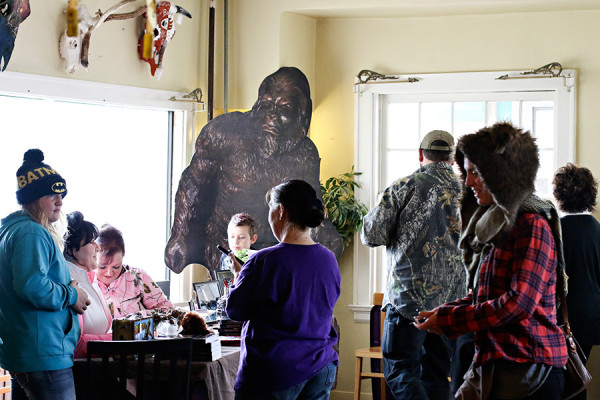
We were directed to the dining room, where the conference organizers had arranged chairs and a stage for the presenters. I sat in the back, for fear of taking a better spot from a true believer.
Technical difficulties pushed us past the starting time of 10 a.m. Behind me, Richard Soule, who runs the Nox Gigas study (Latin for “night giants”), was running a silent auction for the photos he’s taken of tree structures he says Sasquatch make in the forest.
They look like piles of sticks laid upon one another, which, for all intents and purposes, is what they are. But Soule is more interested in who stacked them and why, theorizing that they mark Bigfoot travel paths, burial sites, and territorial markers. The bigger the structure – like those made from living trees – the bigger the creature, Soule says.
A man and a woman take a seat next to me as the room fills up. They are Steve and Karyn Joyce, a pair of siblings who came from Spokane to take part in the conference.
Though they’ve never had a Bigfoot experience of their own – I’ll learn over the next eight hours that asking, “Have you ever had an experience?” here is as common as asking someone’s name – but they grew up with a story of some hippies who went into the woods and saw something that terrified them so much that they left and never went back. The locals, upon further inspection, found massive footprints, along with lodgepole pines snapped in half along what looked like Bigfoot’s escape route.
The Joyces’ perspective on Bigfoot is a popular one among the more skeptical attendees: “We come for the stories,” Karyn said. “Most of what it is is the lore. I don’t know if it really matters if Bigfoot is real or not.”
“I know how empty the woods can be,” Steve added. “It is highly possible for a species to hide. I’ve never seen Bigfoot and I don’t expect to; if I see something, that’s Bigfoot being sloppy.”
Bigfoot, or Sasquatch – the terms seem interchangeable here – is spoken of throughout the day as the ultimate master of secrecy and concealment. For many of the people gathered in this room, it’s the assumption that Bigfoot, and no matter how quickly you turn around to see if something is following or watching you, he or she (yes, there are female Bigfoots) will be faster to hide.
The emcee for the day is Ed Brown, a podcast and YouTube host who interviews big names from the Bigfoot world on a regular basis. He warms up the crowd asking who has had an experience, and a couple dozen hands go up in response, some more timidly than others.
The audience is made up of a wide selection of people, from older, hardened rancher-types to college students to parents and children to the occasional dog wandering through.
When he finally takes the stage, the first thing I notice about Kentucky Bigfoot researcher Michael Cook is his drawl; when he says Bigfoot can be identified by its awful smell, it sounds like “smay-yul.” He’s been featured on the History Channel’s show, “MonsterQuest,” as well as the National Geographic Channel’s “Bigfoot: The New Evidence.”
He begins by asking any hungover audience members who partied the night before during the conference’s evening of live music to raise their hands. Fewer admit to being hungover than to having seen Bigfoot.
Cook then describes his first experience with a Bigfoot in the backwoods, when he skipped school 15 years ago as a teenager because “the fishing was good.”
A 7-to-8-foot creature covered in hair presented itself, and Cook said he stared it in the eyes, a moment in time that has consumed him ever since. He started the Kentucky Sasquatch Research Team, and his organization has since investigated 342 sightings.
Cook is an affable country boy, wearing a laidback plaid shirt, ball cap, and sunglasses on top of his head. His presentation is less about arguing for Bigfoot’s existence and more about how he goes about his investigations; once I walked into this hotel, I entered a place where the existence of a large, bipedal, manlike creature is never in doubt.
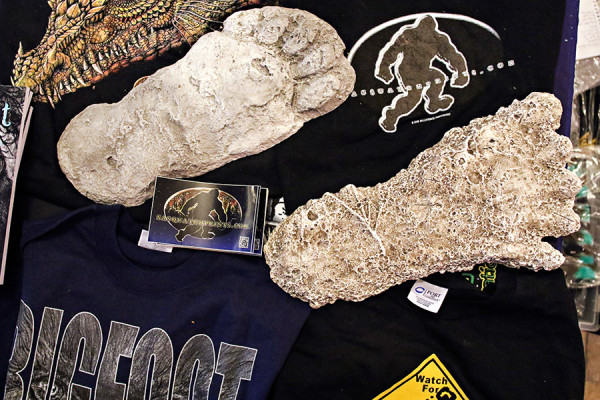
He discusses investigating first and secondhand experiences, while waitresses from the kitchen next to the conference room breeze in and out, carrying plates of breakfast to guests in an adjoining room. During quiet parts of his presentation, the kitchen staff can be heard talking about their own Bigfoot beliefs.
There are a few times I have to willfully suspend my disbelief, like when Cook tells us that 70 percent of Bigfoot sightings are “untold.” I assume he means they are underreported, but his phrasing leaves me stuck with the troubling logic puzzle of trying to prove a negative.
Going against my regular journalism instincts, though, I decide to write off any inconsistencies or scientific confusion that on any other assignment might give me pause. The culture of Bigfoot is one based on belief over evidence to the contrary, in trusting one’s gut and senses, knowing that you saw what you saw, and no one can tell you differently.
The believers gathered in this room must have skin as thick as a Mountain Giant – a vicious cousin-species of Bigfoot known for their flinty, impervious scales – to pursue their passion; each speaker throughout the day remarks about how difficult it can be to coax Bigfoot experiences from others, due to the fear of ridicule.
But gathered here, among birds of their own feather, the Bigfoot believers are electric, forming small groups during any down time to talk about their experiences and stories, to be with people to whom they do not have to explain themselves, with whom they can let down their guards.
It’s clearly a liberating feeling. As the day goes on, more people ask questions during presentations, and more are willing to talk about their own encounters of the Sasquatch kind.
The No. 1 rule of Squatching, according to Cook, is to have fun. He also warns searchers to be mindful about performing Bigfoot calls in the wild – Cook demonstrates, yelling out and grunting – because you can’t be sure what you’re saying to these creatures.
They often use communication like whistling, howling, and noises that sound like a big league slugger taking a practice swing at the trunk of a massive tree. These aren’t the kind of animals you want to upset, he warns.
“What are you yelling at these creatures?” Cook asks. “It might be ‘Your mother is a hooker,’ you don’t know.”
He also talked about sussing out hoax stories, saying that most people who are lying won’t look you directly in the eye. To wit, Cook locks a woman in the audience with a stare and says, “I have seen a Bigfoot. I know what I’ve seen.”
At the end of his slideshow, Cook takes questions about Bigfoot’s eating habits (omnivore) and the frequencies of sightings (most are secondhand), and informs the audience that he’ll be available to sign autographs for $5 a pop.
Next up, author Russell Acord regales the audience with tales of growing up in the Bitterroot Valley, and the idea that a lack of human experiences doesn’t dictate reality.
“I believe in the possibility of Bigfoot,” Acord says. “I believe that there are things out there that we’ve never seen.”
To illustrate that point, Acord then shows a 3-minute, 27-second video of the stars in the Andromeda galaxy for “a little perspective.”
Acord has never seen Bigfoot, but he’s convinced by the stories he’s gathered. He’s a large man, with his close-cropped graying hair likely a throwback to his military days, a black-collared short-sleeve button-up shirt, forearm tattoos, and hands big enough to dwarf the microphone in his hands.
He writes books about a Vietnam veteran who has trouble blending in with society when he comes home from war, and eventually lives with a tribe of Bigfoots. Acord presents another view of Bigfoot, one of a lonely creature that howls not to scare us, but to express its isolation and pain.
When he’s finished, Acord raffles off his new manuscript, one of many intriguing raffle opportunities of the day; the first winner received a DVD of the “Minerva Monster” movie, depicting a legendary 1978 sighting in Minerva, Ohio.
During lunch, I manage to pull conference organizer Sarah Lederle away from her never-ending tasks to chat. She went to a Bigfoot conference in Ohio a while back, and upon her return, a friend asked why she couldn’t do something like that in Montana. She started planning on July 3.
“It’s gone amazingly well,” Lederle said, sitting on a comfortable red couch in the hotel’s lobby. “There are no Bigfoot events like this in our region.”
Lederle is a self-described skeptic without an experience of her own, but she doesn’t want to ignore possibilities she might not yet understand. Plus, all the people she’s encountered in the Bigfoot community have made it an inviting, warm place.
“The community is so welcoming and wonderful as a whole,” she says. “We want a place for people to come and know they’re not alone. This is a no-shame zone.”
Soon, the next speaker on the agenda, Becky Cook (no relation to Michael Cook), is sitting with us. She’s a story collector from Idaho who speaks with anyone who’s had Bigfoot run-ins, and the author of “Bigfoot Lives in Idaho,” and “Bigfoot Still Lives in Idaho.”
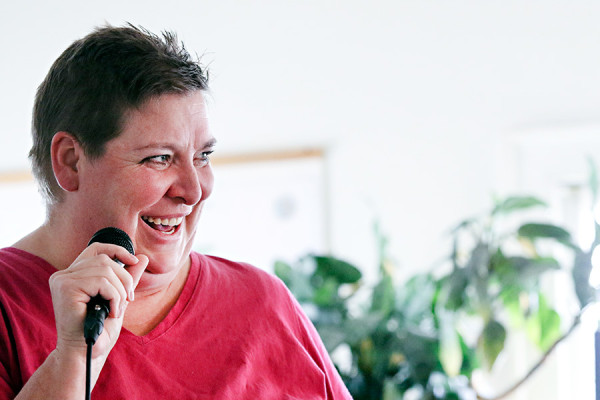
At 6-feet-6-inches tall, Cook is a presence, with short hair, a bold face, and a tiny, almost-shy giggle that escapes from her wide and easy smile. Her Bigfoot experiences started early on as a child, growing up near the Shoshone-Bannock tribes on the Fort Hall Reservation.
The first story she heard was from her father – a local cop – when she was 4 or 5. He was called in for a report of a Bigfoot shaking a trailer off its foundations, after it had already destroyed a nearby pump house. Later on in life, she said she heard the full story, that the person living in the trailer had allegedly taken a potshot at a juvenile Bigfoot, and the avenging creature was likely its mother.
Her perspective on Bigfoot is of a one-of-a-kind, family-based creature. She says the Bigfoots in her area know her, and visit her home often.
“I really don’t care what you think, because I know what I know,” Cook says, not to me in particular, but largely out of reflex.
Gathering stories follows the same path: people are reticent at first, but once they know it’s a conversation safe from ridicule, they open right up.
“That vindication, that’s what I do for people,” she says.
She also asserts that Bigfoots have individual smells, that they’re not all horribly stinky, as Michael Cook suggested. One female Bigfoot who apparently took an amorous liking to an Idaho man left a sweet scent, almost like orchids, she says.
Cook says she’s communicated with the beasts telepathically, and has heard reports of Bigfoots belonging to different dimensions and realms. An Idaho man once told her he followed a large, bipedal, hairy creature over a few hillcrests on a hunting trip, only to find himself 20 feet into a jungle at one point. Walking back, he was in Idaho again.
“We are all made of energy, and we have the ability to send that energy,” Cook said. “God’s wonders are amazing.”
She likes to sing “How Great Thou Art” while walking in the woods, and doesn’t feel the need to photograph her large friends, because it wouldn’t be respectful.
Answers to audience questions for her presentation include disdain for anyone who leaves out alcohol for Bigfoots; the youngest specimen she’s ever seen; and, of course, the inevitable awkward story about a woman impregnated by a Bigfoot (the resulting child lives a hidden life on a reservation, she says).
Brian Sullivan, founder of the Montana Bigfoot Project, takes the completely opposite tack in his presentation, informing us about the dangerous varieties of Bigfoot’s cousins, such as the aforementioned Wendigo and Mountain Giants. These will eat you with little question, he said, and are not friendly like Bigfoot.
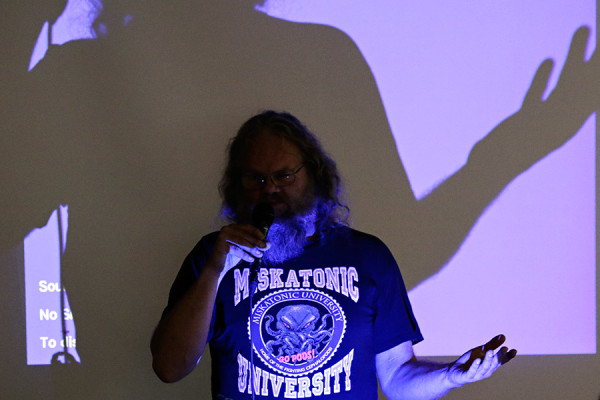
By this point in the conference, several attendees have cracked cans of beer, and some are taking the opportunity to work in a quick nap. Sullivan’s face is obscured by long, gray hair and a thick beard. He wears a Miskatonic University shirt, an homage to the fictional school that first appeared in an H.P. Lovecraft story and has now become part of the Cthulhu mythos.
His presentation delves into old newspaper reports of sightings across the country, and into various species classifications.
When a young girl in the audience asks what would happen if a Wendigo were to break into her house, Sullivan doesn’t sugarcoat his answer: You’d better have a weapon. He then seems to try to mitigate the sheer terror this answer has caused for the girl, by saying these creatures know better than to mess with humans because we’re usually armed and we live in groups.
The final presentation wraps up at about 3:15 p.m., and the group discussion and sharing portion is scheduled to begin at 4 p.m. The Bigfoot lookalike contest, which is supposed to take place at 6 p.m., is canceled due to a lack of participants.
“Maybe next year,” Lederle says in the parking lot with a smile, while loading chairs into a Subaru.
The conference-goers mill around the lobby, not bothering to wait for the scheduled discussion time to share their stories. It is clear that at some point during the day, the mental dam keeping most of these people quiet has been breached, and now the stories are spilling out.
And really, who am I to tell these people what they did or didn’t see, or what they should believe? If we were to look at everything with the skepticism with which society tends to view groups like this, we would all seem a little off.
For example, is it weirder to attend a conference of like-minded individuals to discuss a deeply-felt-but-hard-to-prove belief, or to wear a terrycloth robe in public, en route to sit mostly naked with strangers in warm water that smells like eggs? Both happened at Hot Springs that day.
It’s all about perspective, and on the drive back to Kalispell, I realized mine had changed, at least about the people I’d met. These were some of the nicest, warmest people I’ve spoken with, who put their vulnerabilities on display in an attempt to connect with others – even other species – ridicule be damned.
These are people who have found something in their lives worth their curiosity and, for most of them, their love. Everyone I spoke with would rather face being considered a joke for the rest of their lives than be proven right with a dead Bigfoot.
“If it takes us killing one, I hope we never prove it exists,” Michael Cook said.
Greg and I talked about how even just driving on Highway 93 again made it feel like we were worlds away from Hot Springs and the believers there, who by the time we left, looked like they were preparing for a night of dancing, beer, and stories. The day had lightened up somewhat, but the wind carried with it whispers of winter.
The valleys were beautiful under the snow-gray skies and the terrain is rugged and wild, and I was once again reminded that just like the unknowable creatures of the Earth, people are equally mysterious and varied, and that under the right circumstances, such as a conference where everyone wants to be known and understood, you might just catch a glimpse of something magical.
